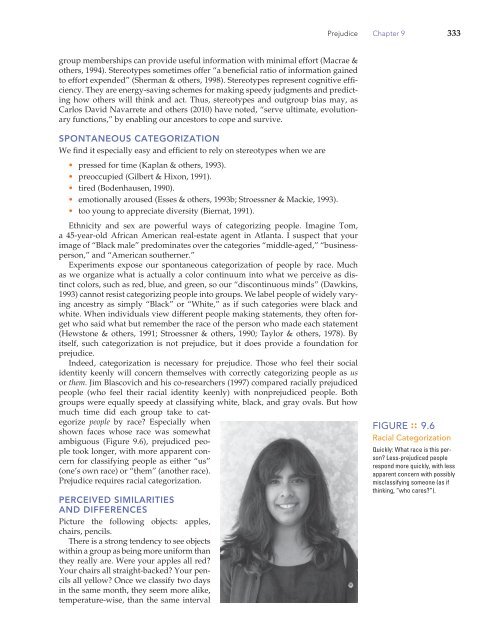Chapter 9: Prejudice: Disliking Others (2947.0K) - Bad Request
Chapter 9: Prejudice: Disliking Others (2947.0K) - Bad Request
Chapter 9: Prejudice: Disliking Others (2947.0K) - Bad Request
You also want an ePaper? Increase the reach of your titles
YUMPU automatically turns print PDFs into web optimized ePapers that Google loves.
group memberships can provide useful information with minimal effort (Macrae &<br />
others, 1994). Stereotypes sometimes offer “a beneficial ratio of information gained<br />
to effort expended” (Sherman & others, 1998). Stereotypes represent cognitive efficiency.<br />
They are energy-saving schemes for making speedy judgments and predicting<br />
how others will think and act. Thus, stereotypes and outgroup bias may, as<br />
Carlos David Navarrete and others (2010) have noted, “serve ultimate, evolutionary<br />
functions,” by enabling our ancestors to cope and survive.<br />
SPONTANEOUS CATEGORIZATION<br />
We find it especially easy and efficient to rely on stereotypes when we are<br />
• pressed for time (Kaplan & others, 1993).<br />
• preoccupied (Gilbert & Hixon, 1991).<br />
• tired (Bodenhausen, 1990).<br />
• emotionally aroused (Esses & others, 1993b; Stroessner & Mackie, 1993).<br />
• too young to appreciate diversity (Biernat, 1991).<br />
Ethnicity and sex are powerful ways of categorizing people. Imagine Tom,<br />
a 45-year-old African American real-estate agent in Atlanta. I suspect that your<br />
image of “Black male” predominates over the categories “middle-aged,” “businessperson,”<br />
and “American southerner.”<br />
Experiments expose our spontaneous categorization of people by race. Much<br />
as we organize what is actually a color continuum into what we perceive as distinct<br />
colors, such as red, blue, and green, so our “discontinuous minds” (Dawkins,<br />
1993) cannot resist categorizing people into groups. We label people of widely varying<br />
ancestry as simply “Black” or “White,” as if such categories were black and<br />
white. When individuals view different people making statements, they often forget<br />
who said what but remember the race of the person who made each statement<br />
(Hewstone & others, 1991; Stroessner & others, 1990; Taylor & others, 1978). By<br />
itself, such categorization is not prejudice, but it does provide a foundation for<br />
prejudice.<br />
Indeed, categorization is necessary for prejudice. Those who feel their social<br />
identity keenly will concern themselves with correctly categorizing people as us<br />
or them. Jim Blascovich and his co-researchers (1997) compared racially prejudiced<br />
people (who feel their racial identity keenly) with nonprejudiced people. Both<br />
groups were equally speedy at classifying white, black, and gray ovals. But how<br />
much time did each group take to categorize<br />
people by race? Especially when<br />
shown faces whose race was somewhat<br />
ambiguous ( Figure 9.6 ), prejudiced people<br />
took longer, with more apparent concern<br />
for classifying people as either “us”<br />
(one’s own race) or “them” (another race).<br />
<strong>Prejudice</strong> requires racial categorization.<br />
PERCEIVED SIMILARITIES<br />
AND DIFFERENCES<br />
Picture the following objects: apples,<br />
chairs, pencils.<br />
There is a strong tendency to see objects<br />
within a group as being more uniform than<br />
they really are. Were your apples all red?<br />
Your chairs all straight-backed? Your pencils<br />
all yellow? Once we classify two days<br />
in the same month, they seem more alike,<br />
temperature-wise, than the same interval<br />
<strong>Prejudice</strong> <strong>Chapter</strong> 9 333<br />
FIGURE :: 9.6<br />
Racial Categorization<br />
Quickly: What race is this person?<br />
Less-prejudiced people<br />
respond more quickly, with less<br />
apparent concern with possibly<br />
misclassifying someone (as if<br />
thinking, “who cares?”).

















